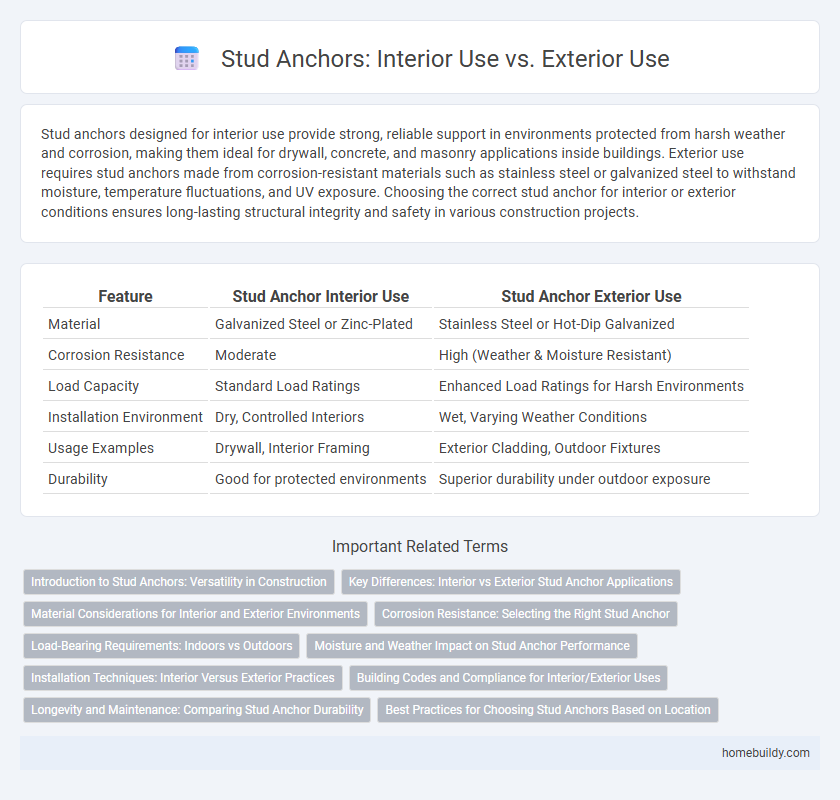Stud anchors designed for interior use provide strong, reliable support in environments protected from harsh weather and corrosion, making them ideal for drywall, concrete, and masonry applications inside buildings. Exterior use requires stud anchors made from corrosion-resistant materials such as stainless steel or galvanized steel to withstand moisture, temperature fluctuations, and UV exposure. Choosing the correct stud anchor for interior or exterior conditions ensures long-lasting structural integrity and safety in various construction projects.
Table of Comparison
| Feature | Stud Anchor Interior Use | Stud Anchor Exterior Use |
|---|---|---|
| Material | Galvanized Steel or Zinc-Plated | Stainless Steel or Hot-Dip Galvanized |
| Corrosion Resistance | Moderate | High (Weather & Moisture Resistant) |
| Load Capacity | Standard Load Ratings | Enhanced Load Ratings for Harsh Environments |
| Installation Environment | Dry, Controlled Interiors | Wet, Varying Weather Conditions |
| Usage Examples | Drywall, Interior Framing | Exterior Cladding, Outdoor Fixtures |
| Durability | Good for protected environments | Superior durability under outdoor exposure |
Introduction to Stud Anchors: Versatility in Construction
Stud anchors provide exceptional versatility in construction by offering robust fastening solutions for both interior and exterior applications. Engineered to secure fixtures to concrete or masonry, they ensure reliable load-bearing support in walls, floors, and ceilings regardless of environmental exposure. Their corrosion-resistant coatings and adaptable installation methods make stud anchors equally effective for structural and decorative uses in diverse settings.
Key Differences: Interior vs Exterior Stud Anchor Applications
Stud anchors designed for interior use typically feature corrosion-resistant coatings suitable for dry environments, whereas exterior stud anchors require enhanced durability with weatherproof and rust-proof treatments for exposure to moisture and harsh conditions. Interior applications prioritize ease of installation and load-bearing capacity with minimal environmental stress, while exterior applications demand anchors that withstand UV radiation, temperature fluctuations, and chemical exposure. Selecting the appropriate stud anchor type based on environment ensures structural integrity and long-term performance in both interior and exterior construction projects.
Material Considerations for Interior and Exterior Environments
Stud anchors for interior use are typically made from corrosion-resistant materials such as zinc-plated steel or stainless steel to withstand indoor humidity without rusting. Exterior stud anchors require more robust materials like hot-dip galvanized steel or stainless steel grades with higher corrosion resistance to endure exposure to rain, UV rays, and temperature fluctuations. Selecting the appropriate material ensures structural integrity and longevity in specific environmental conditions.
Corrosion Resistance: Selecting the Right Stud Anchor
Stud anchors used for interior applications typically require moderate corrosion resistance, often achieved through zinc plating or galvanized finishes suitable for less aggressive environments. Exterior use demands higher corrosion resistance, with stainless steel or hot-dip galvanized stud anchors recommended to withstand weather exposure and prevent deterioration. Proper selection based on environmental conditions ensures long-lasting structural integrity and safety.
Load-Bearing Requirements: Indoors vs Outdoors
Stud anchors designed for interior use often require lower load-bearing capacities since they are embedded in protected environments with minimal exposure to dynamic forces. Outdoor stud anchors must meet higher load-bearing requirements to withstand environmental stresses such as wind, temperature fluctuations, and moisture, which can affect anchor integrity. Selecting the appropriate stud anchor based on load ratings and exposure conditions ensures structural safety and durability in both indoor and outdoor applications.
Moisture and Weather Impact on Stud Anchor Performance
Stud anchors designed for interior use typically perform well in controlled environments where moisture and weather exposure are minimal, ensuring long-term stability and load-bearing capacity. Exterior-use stud anchors must be made from corrosion-resistant materials such as stainless steel or coated steel to withstand moisture, temperature fluctuations, and UV exposure, preventing degradation and failure. Moisture infiltration and weather impact can significantly reduce the holding strength of standard stud anchors, making it essential to select anchors rated for exterior conditions to maintain structural integrity.
Installation Techniques: Interior Versus Exterior Practices
Stud anchors for interior use require installation techniques that prioritize moisture resistance and corrosion protection due to controlled indoor environments, often involving direct embedding into concrete or masonry with epoxy adhesives or mechanical expansion. Exterior stud anchor installation demands enhanced weatherproofing measures and the use of stainless steel or galvanized materials to withstand UV exposure, temperature fluctuations, and precipitation, typically necessitating sealants and protective coatings alongside secure fastening methods. Proper installation techniques differ significantly as interior applications emphasize structural integration and aesthetics, while exterior applications focus on durability and environmental resilience.
Building Codes and Compliance for Interior/Exterior Uses
Stud anchors designed for interior use must comply with building codes that prioritize load requirements and fire-resistance ratings specific to indoor environments, including compatibility with drywall and framing materials. Exterior-use stud anchors require adherence to more stringent codes addressing corrosion resistance, weatherproofing, and structural integrity under varying environmental conditions, often demanding materials like stainless steel or coated finishes. Compliance with local building codes ensures that stud anchors provide safe and reliable performance tailored to their designated interior or exterior applications.
Longevity and Maintenance: Comparing Stud Anchor Durability
Stud anchors used for interior applications typically experience less environmental stress, resulting in longer lifespan and reduced maintenance requirements compared to exterior use. Exterior stud anchors are exposed to harsh weather conditions, moisture, and temperature fluctuations, which can accelerate corrosion and degrade anchor performance over time. Selecting corrosion-resistant materials or applying protective coatings enhances the durability of exterior stud anchors, minimizing maintenance while ensuring structural integrity.
Best Practices for Choosing Stud Anchors Based on Location
Stud anchors designed for interior use typically offer corrosion resistance suited for dry, controlled environments, while exterior-grade anchors feature enhanced weatherproof coatings to withstand moisture and temperature fluctuations. For optimal performance, select interior anchors for drywall or masonry applications inside buildings and exterior anchors for outdoor facades or structures exposed to harsh elements. Properly matching the stud anchor material and finish to the installation environment ensures long-lasting hold and structural integrity.
Stud anchor interior use vs exterior use Infographic

 homebuildy.com
homebuildy.com